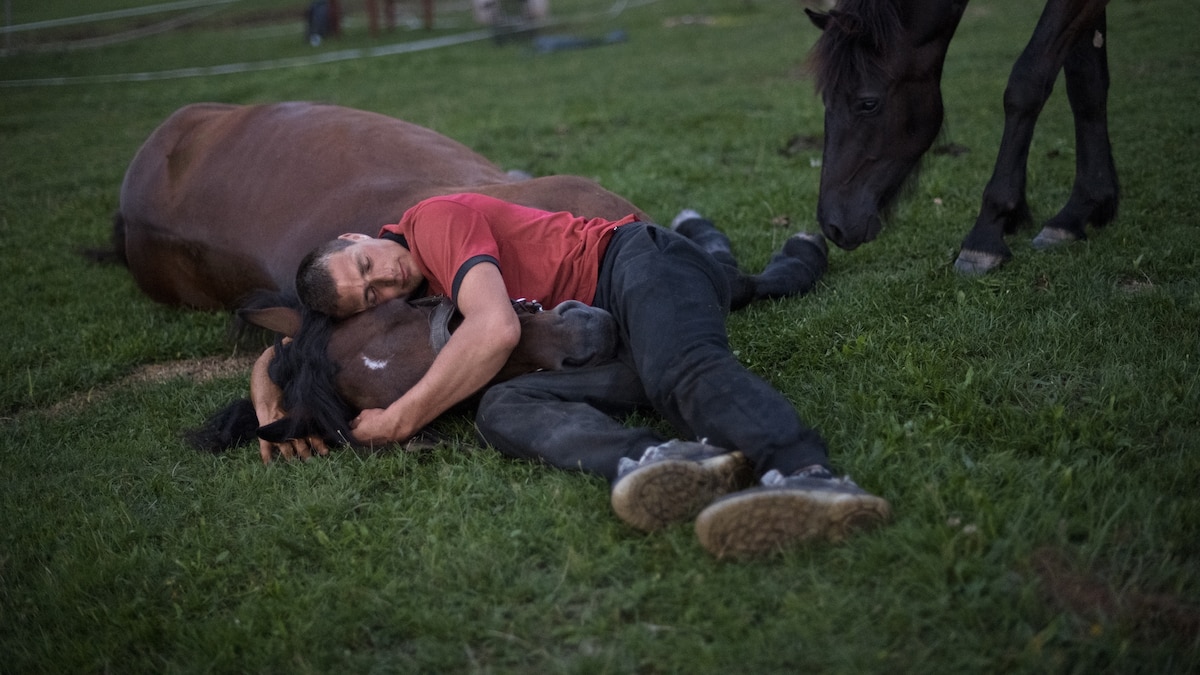Now Reading: Transylvania may hold the secret to a long and happy life
-
01
Transylvania may hold the secret to a long and happy life
Transylvania may hold the secret to a long and happy life

On a chilly twilit evening, three men sit around a wood table in the parsonage of a 13th-century church in Transylvania. Outside are ducks, beehives, and a shaggy white dog that we can hear barking at something in the growing dark. Warmed by a wood-burning stove, the men sip tea and nibble savory, pretzel-shaped cookies, and talk about their home, Karácsonyfalva.
Transylvania. Is there a better known place-name and a lesser known place? (Perhaps Timbuktu.) Even when all of Europe was wilder, Transylvania stood for its wildest edge. This is why Bram Stoker saw fit to use it as a setting for Dracula, despite never setting foot there. It’s a place where Saxons, Huns, Turks, Tartars, and a dozen less famous tribes are still talked about as if they may have passed through just last week, a place where the forests are still filled with bears. Now that Europe, for all its charms, can sometimes seem like a continent of mobile-phone executives, it feels even more thrilling and unlikely to find oneself in a pocket as remote and in many ways untouched as this village in the valley of the Homoród River.
(Dracula-hunting and bear hides—inside the Romanian region that has it all.)

In medieval times, the Hungarian Empire granted Székely villages like Karácsonyfalva control of their lands. This system of communal landownership has persisted, with a few interruptions, for centuries.

Through the plants she grows and the creams and tinctures she concocts, Benedek Enikő is passing on her great-grandmother’s gardening expertise to younger generations.

School outings help teach village children, like Lurcza Csongor, about the local fauna and flora, such as the Fomes fomentarius fungi he found in a nearby forest.

In Karácsonyfalva, the village band fills the streets with music on the first Saturday in October to announce the start of the annual Chestnut Festival celebration.
Like about 85 percent of the people who live in this region of rural central Romania, the men at the parsonage table speak in Hungarian. They are Székelys, ethnic Hungarians who have lived here for at least a thousand years. At the head of the table, with a short gray beard and bright, mischievous eyes, is 70-year-old Orbán Csaba, the man whose vision is helping preserve this distant place, even as the modern world presses at its borders.
Orbán—in Hungarian, family names come before given names—does so as the leader of the Közbirtokosság, the village’s governing body. It’s a centuries-old form of communal landownership and management that has helped make this place so singular. The Közbirtokosság (Kooz-BEER-toh-koh-shag; it helps if you take a running start) manages the water, woods, and pastures, splitting their use, resources, and income among 347 “shareholders.” Though timeworn, the system of governance is remarkably sturdy, Orbán points out, and capable of meeting the needs of the people here. “When winter comes,” he says, “everybody has enough wood.”
“It was like thunder,” he says. “Not even in our deepest dreams could we have hoped to restore what we had.”

After communism’s end, this official record from 1946 was crucial to restoring the Székelys’ landrights.

Szadó Apollónia, shown here to the right of her daughter, Judit, said she hid the official document in her house during Romania’s communist era. Before communism, Apollónia’s father was its caretaker.

Kelemen Lajos planted this chestnut grove in Karácsonyfalva over a century ago. Now it’s a local gathering place and a point of pride for his descendants (from left) Kelemen Előd, Kelemen Imre, and Kelemen Tas.

Even in his 70s, longtime community leader Orbán Csaba is thinking up new ways to honor Székely heritage.
That it exists at all is a testament to Orbán’s vision. For the decades that Romania was under communist rule, the Közbirtokosság was lost. Indeed, the infamous dictator Nicolae Ceaușescu aimed to wipe out places like Karácsonyfalva and their ways of life. He failed, communism fell, and the village regained communal control of some 2,700 acres of land in 2000. Key to the Közbirtokosság’s restoration were written records of the intricate system through which landrights had been passed down for generations. Orbán opens a leather valise and carefully lifts out a thick folder of papers. Each page contains two columns of neatly written names with numbers next to them, a 1936 record of the shareholders of Karácsonyfalva’s Közbirtokosság. It was pages like these, hidden away in houses and buried in archives, that aided the long legal fight of Orbán and other Közbirtokosság leaders to reclaim their villages after Ceaușescu’s overthrow in 1989. Orbán remembers sifting through a mountain of documents in a government office and coming upon the list.

How smelling roses could help you make stronger memories
A scent, a touch, or a sip can be just what you need to lock an important moment into your mind forever.
“It was like thunder,” he says. “Not even in our deepest dreams could we have hoped to restore what we had.”
Joining Orbán at the table is Szentpáli Géza, 75. He is the lay leader of the Unitarian church; the younger man sitting next to him, Benedek Mihály, is its minister. Orbán finds a page from a second list of names—this one from 1946—and points to line 165. Inscribed there is the name of Szentpáli’s grandfather. When I look around the table, all three men are blinking back tears.

Whether on the farm or in the wild, caring for animals is deeply rooted in local culture. An avid hunter, Öcsi Mátyás monitors brown bear, deer, and wolf populations at observation stations he set up in the forest.
Karácsonyfalva (Crăciunel in Romanian) is tucked within rolling Tuscany-like hills and swaths of deep forest, part of a string of villages, each marked by the needlelike spire of a Unitarian church. Its houses are topped with roofs of rust-colored tile. Many feature so-called Székely gates, elaborately carved wooden entrances that depict Székely iconography and runes and are capped with structures reminiscent of a Japanese pagoda. From the courtyards within, you can hear bleats of sheep and squawking of chickens; most families do at least some subsistence farming. Electrical poles are topped by the doughnut-shaped hats of stork nests. One afternoon, I step aside as a raucous herd of cows is paraded down the middle of the street, spurred on by young men with sticks and shouts. (It should also be noted that the village has faster internet and generally better roads than I do at home in New Orleans.)
Orbán Csaba commands obvious respect throughout the village but is also considered something of an eccentric. The heads of other Közbirtokosságs can often be identified by their expensive cars and big-shot attitudes. Orbán drives a beat-up hatchback and dreams up projects. There’s the traditional open-air bath that he renovated in 2019 as a gathering place, complete with a medicinal herb garden and firepit for making tea. Across the village, in the shadow of the forest, is the sweet chestnut orchard where he organizes an annual Chestnut Festival. And there’s the Közbirtokosság community center where, on a Saturday afternoon while I am there, the village gathers in traditional dress to enact a “children’s wedding,” in which a local girl and boy play bride and groom before a great feast. Orbán’s car is in a constant state of reminding him to buckle his seat belt as he careens down dirt roads from one place to the next.

Levente Balázs collects wood, the primary source of heat in Karácsonyfalva during winter. For centuries, the Székelys have practiced careful forest management, so that trees felled for firewood are replaced.
All of the projects, he says, are attempts to maintain the traditions of this place while also cautiously opening it to the possibilities of ecotourism. Orbán often explains this careful balancing act through an emblem depicting the Székely sun and moon standing, independent, within the European Union’s circle of stars.
Above all, the Közbirtokosság acts as a steward of the village’s most important resource: the forest, which is both a source of crucial fuel (as a few nervous nights feeding a guesthouse’s woodstove drives home) and fragile biodiversity. On a rainy day, I am taken into the woods by a hunter and ingenious tinkerer named Öcsi Mátyás. He’s invited me to tag along on his daily visit to check the three motion-activated cameras he uses to monitor wildlife. We bounce up and down deeply rutted trails in an all-terrain vehicle he has fashioned from an old Land Rover and then hike in silence, trailed by a stout fox that Öcsi has grown to know and has named Vuki. Aside from songbirds, Vuki is the only living thing we encounter. But back at Öcsi’s house, while my boots dry over the woodstove, we review the photos he has retrieved. They show deer, wild boars, all manner of small mammals, and many, many bears. I shiver, thinking of them all having been hidden around us as we moved through their woodland home.
(Discover the real Transylvania on a new long-distance hiking trail.)

Professionally, Golicza József tends to herds of cows. After work, he practices dressage, relying on affectionate bonds to train his horses.

In the neighboring Székely village of Homoródújfalu, young cows often graze on the upper pastures during the warmer months. Strolling down the main road, they return home in the evening when families open the gates for them.

Pastor Benedek Mihály greets congregants after services at Karácsonyfalva’s Unitarian Church. The faith’s long history in Transylvania began in the 16th century, after the Protestant Reformation upended European Christianity.
What is special here is that the community owns the land,” says Székely Kinga-Réka, a Unitarian minister several villages away. “Nobody can get too wealthy that they make other people suffer.”
The irony of course is that such principles resemble nothing so much as those of communism, with a small c. “We hate that word, but it’s true,” Székely admits. “We already had that system for a thousand years. We didn’t need them to come tell us!”
I am at Székely’s home for the annual ritual of slaughtering a pig, to be eaten over the course of the rest of the year. By the time I arrive, the animal’s still steaming body has been splayed across a table outside. A round-faced butcher deftly works at disassembling it. Prime cuts go into brine, later to be smoked, while organs and other offal head to a temporary sausage factory set up in the dining room. Excess sausages will be distributed among neighbors, who, in turn, will share their own surplus when the time comes.
Székely’s husband, Zsolt-Csaba, a computer coder, distributes morning shots of pálinka, a homemade brandy they prepared from plums. “My generation is the last one that understands the meaning of butchering the pig,” he laments.
You May Also Like
“What is the meaning?” I ask.

Karácsonyfalva’s open-air bath—financed with communal funds—takes advantage of the mineral spring of Dungó feredõ, whose waters, tradition says, contain medicinal properties.
On the Székelys’ wall, as in many homes in the region, hangs a map showing Transylvania as part of the greater Austro-Hungarian Empire. It’s a good reminder that, as this place knows all too well, there is no hiding from the tides of history. Winters are getting warmer. The past two summers have brought drought. A new Romanian nationalism is on the rise, potentially threatening the country’s ethnic minorities. In the villages of the Homoród Valley, you see children and older people, but few in between; many young adults have left in search of jobs, or Ph.D.’s, or just an easier life than farming. Székely Zsolt-Csaba has been forced to bring in Nepalese workers to help staff one of the small groceries he owns.
In the face of all that, what Orbán Csaba and the Közbirtokosság do is a model of tending one’s own garden—an attempt to protect and sustain family, community, and the gifts of this small corner of the planet that they know better than anybody else. At the parsonage table, Orbán packs up his stack of documents and places them carefully back in their valise. He pats it lovingly and puts it under his arm. “It would be nice to know who is going to hold this next,” he says.
A version of this story appears in the July 2025 issue of National Geographic magazine.























